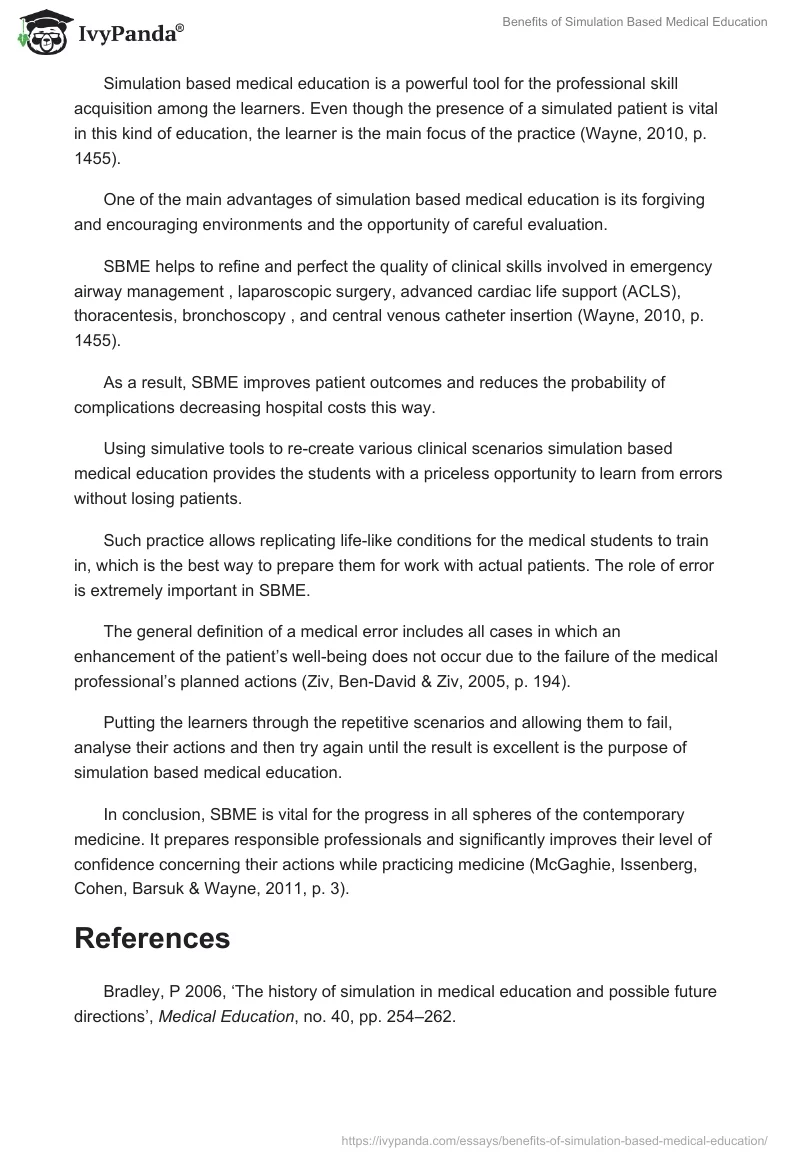The history of clinical simulation in medical education can be traced centuries back; models have been used to teach anatomy for many years.
The development of the application of clinical simulation in medical education is divided into three major movements: the invention of the firs resuscitation manikin, the development of high-fidelity models and the period of educational reforms considering post-graduation education (Bradley, 2006, p. 255-256).
Simulation based education contains numerous benefits for the medical students all around the world.
Clinical simulation can be of different kinds: role playing, standardised patients, part-task training based on physical or virtual reality, or training provided with the employment of a computer or electronic patient (Cooper & Taqueti, 2004, p. 11).
This way, various kinds of medical simulation help to address different skills and abilities medical professionals are required to develop before starting their practice.
The methods and techniques used in stimulation based medical education (SBME) have been perfected for 40 years and they continue to evolve today (McGaghie, Issenberg, Petrusa & Scalese, 2010, p. 50).
Simulation based medical education that employs deliberate practice has high demands considering the duties and assignments of the learners.
First of all, the students involved into such practice are to be highly motivated and devoted to the completion of the difficult tasks. Secondly, this is a repetitive practice with various levels of difficulty, where simulators are able to provide feedback (McGaghie, Issenberg, Petrusa & Scalese, 2010, p. 55).
Finally, it is monitored and carefully evaluated not only by the supervisors but also by the trainees, and this allows them to work out successful approaches and strategies, refine their skills and notice their errors.
Simulation based medical education is a powerful tool for the professional skill acquisition among the learners. Even though the presence of a simulated patient is vital in this kind of education, the learner is the main focus of the practice (Wayne, 2010, p. 1455).
One of the main advantages of simulation based medical education is its forgiving and encouraging environments and the opportunity of careful evaluation.
SBME helps to refine and perfect the quality of clinical skills involved in emergency airway management , laparoscopic surgery, advanced cardiac life support (ACLS), thoracentesis, bronchoscopy , and central venous catheter insertion (Wayne, 2010, p. 1455).
As a result, SBME improves patient outcomes and reduces the probability of complications decreasing hospital costs this way.
Using simulative tools to re-create various clinical scenarios simulation based medical education provides the students with a priceless opportunity to learn from errors without losing patients.
Such practice allows replicating life-like conditions for the medical students to train in, which is the best way to prepare them for work with actual patients. The role of error is extremely important in SBME.
The general definition of a medical error includes all cases in which an enhancement of the patient’s well-being does not occur due to the failure of the medical professional’s planned actions (Ziv, Ben-David & Ziv, 2005, p. 194).
Putting the learners through the repetitive scenarios and allowing them to fail, analyse their actions and then try again until the result is excellent is the purpose of simulation based medical education.
In conclusion, SBME is vital for the progress in all spheres of the contemporary medicine. It prepares responsible professionals and significantly improves their level of confidence concerning their actions while practicing medicine (McGaghie, Issenberg, Cohen, Barsuk & Wayne, 2011, p. 3).
References
Bradley, P 2006, ‘The history of simulation in medical education and possible future directions’, Medical Education, no. 40, pp. 254–262.
Cooper, J B & Taqueti, V R 2004, ‘A brief history of the development of mannequin simulators for clinical education and training’, Qual Saf Health Care vol. 13, no. 1, pp. 11-18.
McGaghie,W C, Issenberg, S B, Cohen, E R, Barsuk J H & Wayne D B 2011, ‘Does Simulation-based Medical Education with Deliberate Practice Yield Better Results than Traditional Clinical Education? A Meta-Analytic Comparative Review of the Evidence’. Acad Med, vol. 86, no. 6, pp. 706–711.
McGaghie, W C, Issenberg, S B, Petrusa, E R & Scalese, J R 2010, ‘A critical review of simulation-based medical education research: 2003–2009’, Medical Education, no. 44, pp. 50–63.
Wayne, D B 2010, ‘Use of simulation-based medical education to improve patient care quality’, Resuscitation, no. 81 pp. 1455–1456.
Ziv, A, Ben-David, S & Ziv, M 2005, ‘Simulation Based Medical Education: an opportunity to learn from errors’, Medical Teacher, vol. 27, no. 3, pp. 193–199.



